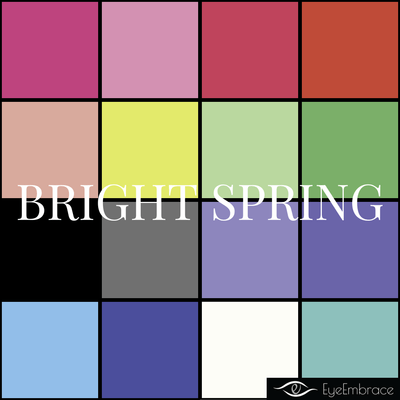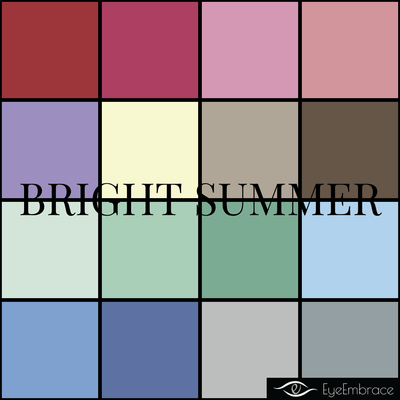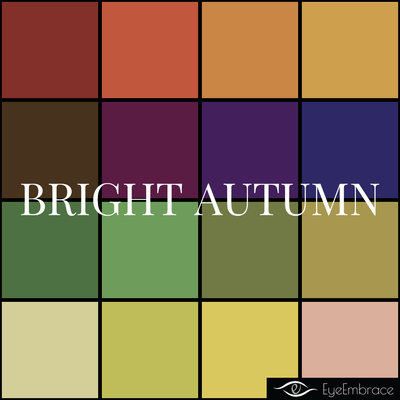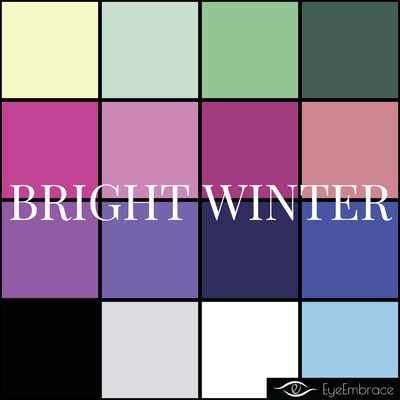Finding Your Season: Using Color Theory to Boost Your Appearance
Have you ever received a makeup or clothing recommendation from a friend, or perhaps admired a color that looked stunning on them, only to find that when you try it on yourself, the color doesn’t seem to work quite right? This common experience can leave many of us questioning our style choices or even our features. However, the real culprit behind this mismatch is often not the color itself, but how it complements our unique skin undertones. Understanding the basics of color theory and how different hues interact with our personal coloring can be a game-changer in elevating our appearance and confidence.
Just a little while back, I took the plunge and decided to have my colors analyzed. I'll admit, I was a bit of a skeptic at first, brushing it off as a passing trend. But was I in for a surprise! The transformation was nothing short of a revelation. Watching my complexion shift from a dull, lifeless grey to a vibrant, glowing canvas with just a simple swap of colored fabric was astonishing. This experience not only changed my wardrobe but also my perspective on how I present myself to the world. It was like unlocking a new level of confidence I never knew I had. Through understanding color theory and its application to personal style, I discovered hues that enhanced my natural tones and enabled me to project my best self. Whether it's the deep greens that make my eyes sparkle or the soft blues that complement my skin tone, I'm now armed with the knowledge to choose colors that truly suit me.
Are you ready to enhance your palette and upgrade your look? It's time to tap into the advances of color theory and craft your personal masterpiece.
DEMYSTYFYING COLOR ANALYSIS
Color analysis may seem like a complex art, but at its core, it's a straightforward practice that can dramatically transform how you see yourself and how others see you. The science behind color analysis is rooted in the concepts of color temperature and undertones. In simple terms, every color has a temperature — cool, warm, or neutral — and every person has an undertone to their skin, which can also be cool, warm, or neutral. The goal of color analysis is to match clothing and makeup colors to your undertone, creating a harmonious look that enhances your natural beauty.


The most common method of determining the best colors for an individual is through the concept of seasonal palettes. This approach classifies personal colorings into four categories based on the seasons—Spring, Summer, Autumn, and Winter—with each season representing a set of characteristics and color palettes that complement different skin undertones. For instance:
- 🌷 Spring individuals have warm undertones with clear, vibrant eyes and hair; they shine in warm, soft colors like peach, coral, and creamy yellows.
- 🌞 Summer folks often have cool undertones with softer, muted features, flourishing in cool pastels and light, airy hues.
- 🍂 Autumn types usually boast warm undertones with rich, earthy features, looking their best in deep, saturated colors like olive, gold, and burnt orange.
- ❄️ Winter individuals have cool undertones with high contrast between their hair, skin, and eye color, making them stunning in bold, cool shades such as true white, black, and jewel tones.
WHAT SEASON AM I?
There are different methods to discover which season you belong to; the most accurate being professional draping, where a color consultant drapes various colored fabrics near your face to observe which hues enhance your natural features. However, for those looking for a quick glimpse into their potential palettes, online quizzes can provide a starting point. And now, with advancements in artificial intelligence, even tools like chatGPT can offer personalized color advice based on descriptions of your appearance and preferences.
Understanding and applying the principles of color analysis can seem daunting at first, but with a bit of exploration and experimentation, it's possible to discover the colors that best complement you.
My Color Analysis Journey
When I first approached color analysis, I opted for a professional consultation where an expert draped different colored fabrics over me to determine which hues best complemented my natural features. I'll admit, I was highly skeptical at first. The idea that simply changing the color of my clothes could profoundly affect my appearance seemed far-fetched. I couldn't have been more wrong! Attending the session with a friend was an eye-opener. Colors that made her face appear bright and youthful had the opposite effect on me, rendering my complexion dull and aged. Conversely, colors that flattered me best seemed to add years onto her.
Through this process, I discovered I'm a "Muted Autumn", which is also sometimes known as "Soft Autumn". This revelation was nothing short of astonishing. I have both blue and green colored veins on my wrists, so I always knew I had neutral undertones. What shocked me the most was finding out that soft earth tones - colors I had scarcely considered before - were truly my best match. Given that a staggering 90% of my wardrobe was comprised of stark black and white pieces, this insight inspired a wardrobe overhaul. Grey, taupe, and off-white, colors I had previously overlooked, were suddenly my most flattering options. This experience not only revolutionized my wardrobe but also my perspective on personal style. I realized that my skin undertone is the foundation to building a flattering and cohesive wardrobe.
Discovering my season not only enhanced my understanding of makeup choices but also validated my minimal makeup approach. The color analysis confirmed that heavy makeup isn't for me - no eyeshadow, just a hint of peachy blush if I decide to use any. What amazed me was the technician's suggestion to switch from black eyeliner to brown. Trying brown eyeliner transformed my look, making my face appear more inviting, softer, and even younger! It's incredible how such a subtle shift in makeup shade can make such a noticeable difference in one's appearance.
STEP-BY-STEP GUIDE TO DETERMINING YOUR SEASON
Determining your season hinges on understanding your relationship with color, primarily through temperature/hue, light value, and chroma.
- Temperature/hue refers to the warmth or coolness of a color, indicating whether it leans more towards the yellow/red spectrum (warm) or the blue/green spectrum (cool).
- Light value assesses the brightness or darkness of a color, essentially determining how light or shadowed a color appears.
- Chroma measures the purity or intensity of a color, distinguishing between vivid, saturated colors and dull, muted ones.
This may sound overwhelming, but with some guidance, you can quickly and accurately identify your season. Here is a simplified breakdown are a few steps to get started:
Call out text here
The Color Wheel: Basis of All Color Harmony
Understanding the color wheel is fundamental. The wheel is your guide to mixing and matching colors in a way that harmonizes with your seasonal palette.
- Primary, Secondary, and Tertiary Colors: The color wheel starts with three primary colors: red, blue, and yellow. Combining these yields secondary colors (green, purple, orange), and mixing primary with secondary colors gives us the tertiary colors, providing a rich palette from which to work.
- Color Relationships: The wheel allows us to see how colors relate. For instance:
- Complementary Colors: Located directly opposite each other on the wheel (e.g., blue and orange), complementary colors create high contrast and vibrant looks.
- Analogous Colors: These colors sit next to each other on the wheel (e.g., blue and green) and offer a more harmonious, less contrasting look.
- Triadic Harmony: Triadic schemes involve colors that are evenly spaced around the color wheel, like red, blue, and yellow, offering a vibrant palette with balance.
By understanding and applying these concepts, you can begin to decipher which season you most align with. Remember, this exploration is not about strict rules but about discovering what enhances your unique beauty. Experiment with different hues and shades, reflect on the feedback from the color wheel, and most importantly, notice how certain colors make you feel. Your season should empower you, highlighting your features and enhancing your natural beauty.
Practical Applications of Color Analysis
Once you've determined your seasonal palette, it's time to put it into practice! Here are some practical ways to incorporate color analysis into your daily routine:
- Clothing: Use your seasonal color palette as a guide to select clothing colors that enhance your natural features. For example, if you're a Spring, opt for warm, soft shades like peach and coral; if you're a Winter, go for bold, cool tones such as jewel tones and true whites.
- Makeup: Equally important as your clothing choices, the colors of your makeup play a crucial role in highlighting your best features. Utilizing your seasonal palette to guide your makeup selection can enhance your natural beauty effortlessly. If you're a Summer, consider soft, cool shades like rosy pinks and lavender for your lips and cheeks, while a smoky grey or muted navy can accentuate your eyes without overpowering them. Autumns, on the other hand, can revel in the richness of golds, bronzes, and deep terracottas that echo the warmth of their season. Winters benefit from bold, cool colors; think of a classic red lip or a striking silver eyeshadow to bring a chic contrast against their skin. Springs can add a fresh pop of color with peachy blushes and coral lipsticks that reflect their vibrant, warm undertones. Remember, the goal is to complement, not compete with, your natural coloring—choosing the right makeup shades can make all the difference in presenting a cohesive and polished look.
- Accessories: Introducing accessories in the right colors can elevate your outfit to the next level. For example, if you're an Autumn wearing a neutral-colored outfit, adding a burnt orange scarf or gold earrings can bring warmth and depth to your look. Winters can opt for statement jewelry pieces in cool tones like silver or white gold, while Summers may benefit from delicate, pastel-colored accessories such as a pale pink scarf or sky blue handbag. Springs can incorporate their signature warm tones in playful ways, like a pair of bright yellow shoes or a turquoise statement necklace.
- Transitioning to Gray or White Hair: As your hair transitions to gray or white, you might notice a shift in how certain colors complement your skin and overall look. Just like how you need to adjust your makeup to suitable makeup for gray hair, this change in hair color can affect your seasonal color analysis, potentially transitioning you from warmer to cooler tones or vice versa, depending on how the gray or white interacts with your skin's undertone. For instance, someone who was classified as an Autumn with deep, warm hair might find themselves better suited to Winter's palette as their hair turns silver, highlighting a cooler contrast against their skin. It's essential to reassess your wardrobe and makeup choices to accommodate this shift. Adapting to cooler or softer shades in clothing and accessories can harmonize with the cooler highlights in your hair, making you look more vibrant and rejuvenated. This transition offers an exciting opportunity to explore new colors and redefine your style to match your evolving beauty.
Harmonizing Your Look with the Right Makeup and Outfits
Crafting a harmonious look that accentuates your natural beauty is an art form, rooted deeply in the principles of color theory. By aligning your makeup and outfits with your seasonal color palette, you not only enhance your features but also express your unique personality with confidence. Below, discover tailored recommendations for each of the eight color theory seasons, ensuring that your makeup and clothing choices resonate perfectly with your individual style.
Muted Spring
- Makeup: Opt for soft, peachy tones in your blush and lip colors, with a gentle bronze or soft gold for eyeshadows. These shades complement the warm and subdued essence of Muted Spring.
- Clothing: Choose clothing in warm, muted colors like salmon, moss green, or a soft mustard. These colors effortlessly echo the gentle awakening of spring, flattering your natural palette.
- Transitioning to gray or white hair as a Muted Spring does not fundamentally change your seasonal color palette, but it may subtly shift which shades within that palette are most flattering. Gray or white hair introduces a cool tone to your overall appearance, which can influence how certain colors work with your complexion. While you still look best in warm, muted colors, you might find that slightly cooler or more neutral versions of these colors complement your hair and enhance your natural beauty. For example, a Muted Spring with gray or white hair may gravitate towards softer taupe, lavender-infused grays, or muted teal, which harmonize with their new hair tone while staying true to their warm, soft essence. It's an opportunity to experiment within your palette and discover new favorite hues that celebrate this change.
Bright Spring
- Makeup: Vibrant coral lips and cheeks bring your face to life, while eyeshadows in bright turquoise or emerald green make your eyes pop. Bright Spring individuals shine in vivid, clear colors.
- Clothing: Wear clothes in bright and warm shades such as Kelly green, true red, or sunny yellow. These colors perfectly match the bright and dynamic nature of Spring.


Muted Summer
- Makeup: Soft, cool hues like dusky rose for lips and cheeks and a lavender or grey eyeshadow create a harmonious look. Muted Summer's essence is captured in these subdued yet cool tones.
- Clothing: Select garments in cool, muted colors such as slate blue, mauve, or light grey. These hues mirror the tranquil and soft mood of Summer, enhancing your natural serenity.
Bright Summer
- Makeup: Bright pinks and roses on the lips and cheeks resonate with Bright Summer's vibrant energy, complemented by eyeshadows in cool blues or purples.
- Clothing: Choose outfits in vivid, but still cool shades like raspberry, bright periwinkle, or a rich teal, embodying the lively yet cool essence of Summer.


Muted Autumn
- Makeup: Warm, earthy tones such as terracotta for lips and a soft, muted olive or bronze for the eyes highlight the depth of Muted Autumn individuals.
- Clothing: Opt for clothing in rich, muted earth tones like burnt orange, olive green, or a deep caramel. These shades celebrate the warmth and richness of Autumn, mirroring its subdued elegance.
Bright Autumn
- Makeup: Bold, warm shades like copper on the eyes or a deep brick red for lips and cheeks perfectly match the dynamic and warm nature of Bright Autumn.
- Clothing: Wear bold, warm colors that echo the season's bounty, such as pumpkin orange, deep teal, or a rich gol


Deep Winter
- Makeup: Opt for cool, soft shades on the lips and cheeks, with a smoky eye in grey or taupe to reflect Deep Winter's understated elegance.
- Clothing: Choose outfits in cool, deep, muted colors like charcoal, soft navy, or cool burgundy. These hues enhance the cool and sophisticated aura of Winter, aligning perfectly with its muted aspect.
Bright Winter
- Makeup: Dramatic cool-toned makeup such as a bold, true red lip or a striking plum blush, paired with shimmery silver or icy blue eyeshadow, celebrate Bright Winter's vibrant contrast.
- Clothing: Select clothing in clear, vibrant cool colors like hot pink, icy turquoise, or a vivid cobalt blue. These shades highlight the radiant and bold nature of Winter, bringing your look to life.


Your Personal Season, Your Personal Journey
By thoughtfully aligning your makeup and outfit choices with your color season, you can create looks that not only turn heads but also feel inherently 'you'. Remember, the goal of color analysis is to empower you to showcase your unique beauty and personality, harmonizing your external appearance with your inner essence.
The key takeaway is that the perfect palette can profoundly accentuate your beauty, confidence, and presence. A simple shift in the shades of your makeup or the colors in your wardrobe can transform not just your appearance, but how you feel and are perceived. This isn't about conforming to the latest trends but about discovering and enhancing your innate beauty through color analysis. If you're on a quest to refine your look and express your unique self with more vibrancy and harmony, venturing into color analysis might just be your next thrilling chapter!
Remember, every color tells a story, and with the right hues, you can narrate yours in the most captivating light. Here's to celebrating and embracing the power of your unique coloring, and may your personal palette paint a portrait of possibility that’s as rich and radiant as you are!












